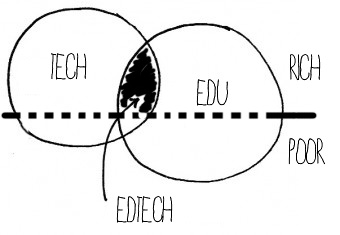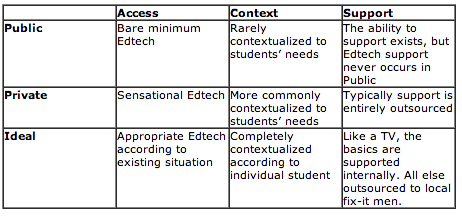Technology in Education is Classist

A debate between Private School technology and Public School technology is actually a debate between Rich kids technology and Poor kids technology. Is it not?
Rich isn’t just about money, its also about the luxury of time and the human capacity to prioritize where to invest money and time to get the greatest return for the individual, family, and community. My claim is that educational technology is classist in its current form. In order for educational technology to become truly class transcending the very basic challenges of wealth and access need to be overcome.
Yes, the differences between the Rich kids private schools and the Poor kids public schools recently became more complex – we now have “affordable” private schools that serve poor kids also! So let’s leave the politically correct jargon aside, and speak more directly about “class”- in this case, the average socioeconomic standard of living of the students’ families in the school (not defined as race or religion here).
Since this specific debate covers ICT4D and the “developing world” – we can all safely assume that Private schools tend to serve richer families than Public schools in the developing world. So let’s call this what it is: the potential for technology for different classes.
Technology alone is slightly classist
Technology, in its essence, was built to make difficult processes more efficient. Inherently, technologies are made to enable widespread access to the same quality thing. An iPad, for example, is the same when sold to a rich person as it is when sold to a less rich person.
Technology on its own is only slightly classist – it hopes to reach all, while it is truly only accessible to those who can afford it. Only people with the savings to buy that iPad can buy it. Technology is often built with context in mind. The iPad comes with the option for electronic sign-up for 3G services in the USA and is unlocked for self-catered 3G in other countries.
Support for technology is offered to anyone who can access and afford it. App developers will sell you apps and screen replacement techs will fix your cracked screen, no matter who you are. Technology as it stands, in its various forms, is mostly tolerant.
Education alone is slightly classist
Education, in its essence, was built to make difficult people more efficient. Education was built on the premise that with proper curriculum and proper shepherding, children would no longer grow into societally inept human beings, but rather valuable additions to an ever-changing world.
Education on its own is only slightly classist as well – it hopes to reach all, even those who cannot afford it. Education today is inevitably contextualized, with local teachers normally teaching students- offering the information to them in local languages and with realistic examples that make sense. Support for education is generally available- when infrastructure or systems break down in a school, both public and private, there is usually enough hierarchy in place to band-aid the problem.
When Education and Technology are tossed together into one mix, the result is a lot less class tolerant than the components on their own. Why? In order for a technology in education to succeed, there are three factors that must overcome all odds:
- Access
- Context
- Support
All three factors require resources – time, money, capacity – that greatly favor and advantage the rich.
Access is limited to the Rich
As stated earlier, both education and technology on their own fail to overcome the access barrier in its entirety. When combined, the barrier gets higher, and the failure rate follows along with it. Most education technology inventions are not accessible to the poor.
Historically speaking, one of the few technologies that have had widespread impact on education is the printing press. But the printing press was primarily a tool for rich and well-educated scientists for 5 decades before it was able to produce books en masse for the greater populace. Now, luckily, the education technology called the printing press is no longer supremely classist- books are accessible to most income levels, though literacy, the ability to access this technology, is not yet as widespread as the books themselves.
Context is focused on the rich
Most educational technology tools take context into mind until they try to reach scale. Take, for example, Khan Academy. Sal Khan started out creating high quality, highly individualized and contextualized videos for his cousins to learn mathematics on their own.
Over time as Khan Academy accessed more and more learners, the videos lost their connection to the individual learner- both in language and in relation. Now, Khan allows others to translate and subtitle his videos, but they reach a majority of non-United States learner’s ears devoid of the exact value they initially offered to his direct cousins.
Context is not just about language. It’s about relating to the material. Language does become the gateway to accessing the material, though. On a global level, the entire Internet is biased towards English speakers. 57% of the Internet is in the English language- while only 16% of the world’s 7 billion people speak any English at all.
Education that’s offered through the conduit of technology is rarely contextualized for poor learners.
Support is nearly impossible without money
The difficulty with education technology is the hope the creator has for it to reach massive scale. With such complex systems in place in both the public and private schools of education, supporting the training and upkeep of the innovation becomes unthinkable.
Take the TV, for example. Training someone to use a TV is about a 2-minute learning curve. The nearest adult could help guide and fix most of the basic problems that might occur when using a TV. The parts that require replacement on a TV as well as the people who can make the fix are widely and easily available. People support the tool because it’s a win-win endeavor- the consumer is willing to pay the supporter to get their TV back in working shape.
This is not true with educational technologies. Teachers know how to support education. Mechanics and geek squads know how to support technologies. Very few people know how to support both together. It’s not a win-win situation because no one is willing to pay the supporter to get the edutech back in working shape. And those that do are definitely not available in poor areas, but they can sometimes be found in rich kid’s schools.
3 class-transcending technology exceptions
In the midst of these issues, there are a few technologies that have almost universal access, context, and support.
Here are three:
The Mobile Phone
Somehow, the mobile phone has weaved it’s tiny little self through all walks of life. Not only is it accessible, it’s contextualized and it’s supported. It’s not yet an educational technology for all- but it’s quickly getting there with projects like Eneza Education (formerly known as MPrep)- where students can prepare for an exam over their mobile phone.
The TV
The TV has reared its ugly head into almost every home I’ve ever visited. It has become an accessible and contextualized technology. A lack of moving parts make it simple to support as well. Unfortunately, only a few companies have capitalized upon the TV to make it educational- like Sesame Street.
The Pencil
Scoff as we may, the pencil was once a technological innovation. Today, it is widely accessible. It requires no contextualization what so ever, while it can be individualized as per any student’s needs (pointed sharp/blunt, fat/thin, long/short). The support for when it breaks down is as simple as it gets. From an educational perspective, the pencil has been a revolutionary tool.
Not Event Rich Kids Schools do EduTech Right Though
Educational technology is implemented in very different ways in Public schools vs Private schools when it comes to the three imperative factors. My claim is that neither privates nor publics apply Edutech in an ideal fashion.

Ideally, an intentional and intelligent Edutech implementation would take into account the surroundings, infrastructure, and existing technologies of a school prior to allowing students to access the new product. It would ensure the content was contextualized to the needs of that specific school and its students. It would be supported by local teachers, administrators, and parents initially. Then it would be sent out for repair as and when needed, with nearby, efficient turnaround to ensure no student is left behind.
This is possible in both Private and Public schools. All it takes is a little research, a lot of planning, a ton of dedicated support, and the political will to focus the required economic capital on equal education for all.
So, how can we break through the edutech class lines? What are you doing to make access, context, and support available in all children’s schools?
